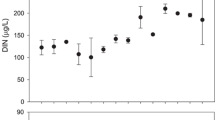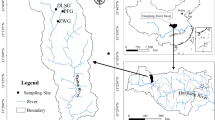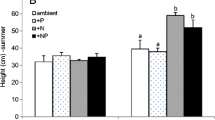Abstract
Algal polyunsaturated fatty acids (PUFA), essential for somatic growth and reproduction of aquatic animals, are influenced by ambient environmental conditions, including light and nutrients. Few studies have addressed the extent to which changes in algal PUFA can influence stream herbivore PUFA profiles and the implications for stream food webs. We manipulated subtropical stream periphyton by applying two light levels (open and shaded canopy) and two nutrient regimes (ambient and enriched) to investigate the response of PUFA and somatic growth in stream herbivores. After 6 weeks, the relative content of periphyton PUFA (%) changed distinctly and differed among treatments. Periphyton in the control treatment with open canopy showed a decline in eicosapentaenoic acid (EPA) relative to initial conditions, whereas shading increased EPA and total highly unsaturated FA (HUFA), but decreased α-linolenic acid (ALA), linoleic acid and total C18 PUFA. The interaction of open canopy and added nutrients increased periphyton ALA compared with initial conditions, while the combined effects of shading and added nutrients led to greater total HUFA. FA similarity between stream grazers (the mayfly Austrophlebioides and caddisfly Helicopsyche) and periphyton increased with periphyton HUFA content. In addition, the growth of large instars of both grazers also increased in response to increased periphyton HUFA %. Our findings show that environmental changes, associated with riparian canopy and nutrients, can lead to changes in periphyton PUFA composition that in turn affect growth and PUFA composition in stream grazers.



Similar content being viewed by others
References
Ahlgren G, Vrede T, Goedkoop W (2009) Fatty acid ratios in freshwater fish, zooplankton and zoobenthos—are there specific optima? In: Arts MT, Brett MT, Kainz MJ (eds) Lipids in aquatic ecosystems. Springer, New York, pp 147–178
Apha A (1995) WPCF, Standard methods for the examination of water and wastewater. American Public Health Association/American Water Works Association/Water Environment Federation, Washington, DC
Bates D, Maechler M, Bolker B (2012) lme4: linear mixed-effects models using S4 classes (2011). R package version 0.999375-42
Brett MT, Müller-Navarra D (1997) The role of highly unsaturated fatty acids in aquatic foodweb processes. Freshwater Biol 38:483–499
Brett MT, Muller-Navarra D, Ballantyne AP, Ravet JL, Goldman CR (2006) Daphnia fatty acid composition reflects that of their diet. Limnol Oceanogr 51:2428–2437
Brett MT, Müller-Navarra DC, Persson J (2009) Crustacean zooplankton fatty acid composition. In: Arts MT, Brett MT, Kainz MJ (eds) Lipids in aquatic ecosystems. Springer, New York, pp 115–146
Bunn S, Davies P, Mosisch T (1999) Ecosystem measures of river health and their response to riparian and catchment degradation. Freshwater Biol 41:333–345
Burns CW, Brett MT, Schallenberg M (2011) A comparison of the trophic transfer of fatty acids in freshwater plankton by cladocerans and calanoid copepods. Freshwater Biol 56:889–903
Cashman MJ, Wehr JD, Truhn K (2013) Elevated light and nutrients alter the nutritional quality of stream periphyton. Freshwater Biol 58:1447–1457
Cummins KW, Klug MJ (1979) Feeding ecology of stream invertebrates. Annu Rev Ecol Syst 10:147–172
Davis JM, Rosemond AD, Eggert SL, Cross WF, Wallace J (2010) Nutrient enrichment differentially affects body sizes of primary consumers and predators in a detritus-based stream. Limnol Oceanogr 55:2305–2316
Frazer GW, Canham C, Lertzman K (1999) Gap Light Analyzer (GLA), version 2.0: imaging software to extract canopy structure and gap light transmission indices from true-colour fisheye photographs, users manual and program documentation. Simon Fraser University, Burnaby, BC; Institute of Ecosystem Studies, Millbrook, NY
Galloway AW et al (2015) A fatty acid based Bayesian approach for inferring diet in aquatic consumers. PLoS One 10:e0129723
Gladyshev MI, Sushchik NN, Dubovskaya OP, Makhutova ON, Kalachova GS (2008) Growth rate of Daphnia feeding on seston in a Siberian reservoir: the role of essential fatty acid. Aquat Ecol 42:617–627
Goedkoop W, Demandt M, Ahlgren G (2007) Interactions between food quantity and quality (long-chain polyunsaturated fatty acid concentrations) effects on growth and development of Chironomus riparius. Can J Fish Aquat Sci 64:425–436
Guo F, Kainz MJ, Sheldon F, Bunn SE (2015) Spatial variation in periphyton fatty acid composition in subtropical streams. Freshwater Biol 60:1411–1422
Guschina IA, Harwood JL (2006) Lipids and lipid metabolism in eukaryotic algae. Prog Lipid Res 45:160–186
Guschina IA, Harwood JL (2009) Algal lipids and effect of the environment on their biochemistry. In: Arts MT, Brett MT, Kainz MJ (eds) Lipids in aquatic ecosystems. Springer, New York, pp 1–24
Heissenberger M, Watzke J, Kainz MJ (2010) Effect of nutrition on fatty acid profiles of riverine, lacustrine, and aquaculture-raised salmonids of pre-alpine habitats. Hydrobiologia 650:243–254. doi:10.1007/s10750-010-0266-z
Hill WR, Rinchard J, Czesny S (2011) Light, nutrients and the fatty acid composition of stream periphyton. Freshwater Biol 56:1825–1836
Hosomi M, Sudo R (1986) Simultaneous determination of total nitrogen and total phosphorus in freshwater samples using persulfate digestion. Int J Environ Stud 27:267–275
Iverson SJ (2009) Tracing aquatic food webs using fatty acids: from qualitative indicators to quantitative determination. In: Arts MT, Brett MT, Kainz MJ (eds) Lipids in aquatic ecosystems. Springer, New York, pp 281–308
Kainz MJ, Arts MT, Mazumder A (2004) Essential fatty acids in the planktonic food web and their ecological role for higher trophic levels. Limnol Oceanogr 49(5):1784–1793
Kainz MJ, Johannsson OE, Arts MT (2010) Diet effects on lipid composition, somatic growth potential, and survival of the benthic amphipod Diporeia spp. J Gt Lakes Res 36:351–356
Lamberti GA, Ashkenas LR, Gregory SV, Steinman AD (1987) Effects of three herbivores on periphyton communities in laboratory streams. J N Am Benthol Soc:92–104
Lau DC, Sundh I, Vrede T, Pickova J, Goedkoop W (2014) Autochthonous resources are the main driver of consumer production in dystrophic boreal lakes. Ecology 95:1506–1519
Martin-Creuzburg D, von Elert E, Hoffmann KH (2008) Nutritional constraints at the cyanobacteria-Daphnia magna interface: the role of sterols. Limnol Oceanogr 53:456–468
Masclaux H, Bec A, Kainz MJ, Perriere F, Desvilettes C, Bourdier G (2012) Accumulation of polyunsaturated fatty acids by cladocerans: effects of taxonomy, temperature and food. Freshwater Biol 57:696–703
McKenny C (2005) The diversity of macroinvertebrate grazers in streams: relationships with the productivity and composition of benthic algae. Griffith University, Nathan
Morgan-Kiss RM, Priscu JC, Pocock T, Gudynaite-Savitch L, Huner NP (2006) Adaptation and acclimation of photosynthetic microorganisms to permanently cold environments. Microbiol Mol Biol Rev 70:222–252
Mosisch TD, Bunn SE, Davies PM (2001) The relative importance of shading and nutrients on algal production in subtropical streams. Freshwater Biol 46:1269–1278
Muller-Navarra DC (2006) The nutritional importance of polyunsaturated fatty acids and their use as trophic markers for herbivorous zooplankton: does it contradict? Arch Hydrobiol 167(1):501–513
Müller-Navarra D (1995) Evidence that a highly unsaturated fatty acid limits Daphnia growth in nature. Arch Hydrobiol 132:297–307
Müller-Navarra DC, Brett MT, Liston AM, Goldman CR (2000) A highly unsaturated fatty acid predicts carbon transfer between primary producers and consumers. Nature 403:74–77
Müller-Navarra DC et al (2004) Unsaturated fatty acid content in seston and tropho-dynamic coupling in lakes. Nature 427:69–72
Napolitano GE (1999) Fatty acids as trophic and chemical markers in freshwater ecosystems. In: Arts MT, Wainman BC (eds) Lipids in freshwater ecosystems. Springer, New York, pp 21–44
Oksanen J et al (2013) Vegan: community ecology package. R package version 2.0-10. http://cran.r-project.org/package=vegan
Parrish CC (2009) Essential fatty acids in aquatic food webs. Lipids in aquatic ecosystems. Springer, New York, pp 309–326
Persson J, Vrede T (2006) Polyunsaturated fatty acids in zooplankton: variation due to taxonomy and trophic position. Freshwater Biol 51:887–900
Piepho M, Arts MT, Wacker A (2012) Species-specific variation in fatty acid concentrations of four phytoplankton species: does phosphorus supply influence the effect the light intensity or temperature? J Phycol 48:64–73
R Core Team (2014) R: a language and environment for statistical computing. R Foundation for Statistical Computing, Vienna. http://www.R-project.org/
Ravet JL, Brett MT, Arhonditsis GB (2010) The effects of seston lipids on zooplankton fatty acid composition in Lake Washington, Washington. Ecology 91:180–190
Redfield AC (1958) The biological control of chemical factors in the environment. Am Sci 46:230A–221
Sargent J et al (1999) Lipid nutrition of marine fish during early development: current status and future directions. Aquaculture 179:217–229
Smyntek PM, Teece MA, Schulz KL, Storch AJ (2008) Taxonomic differences in the essential fatty acid composition of groups of freshwater zooplankton relate to reproductive demands and generation time. Freshwater Biol 53:1768–1782
Stanley-Samuelson DW (1994) Assessing the significance of prostaglandins and other eicosanoids in insect physiology. J Insect Physiol 40:3–11
Sterner RW, Elser JJ (2002) Ecological stoichiometry: the biology of elements from molecules to the biosphere. Princeton University Press, Princeton
Strayer DL (1991) Perspectives on the size structure of lacustrine zoobenthos, its causes, and its consequences. J N Am Bentholog Soc 10:210–221
Sushchik N, Gladyshev M, Kalachova G, Makhutova O, Ageev A (2006) Comparison of seasonal dynamics of the essential PUFA contents in benthic invertebrates and grayling Thymallus arcticus in the Yenisei river. Comp Biochem Physiol Part B 145:278–287
Torres-Ruiz M, Wehr JD, Perrone AA (2007) Trophic relations in a stream food web: importance of fatty acids for macroinvertebrate consumers. J N Am Benthol Soc 26:509–522
Torres-Ruiz M, Wehr JD, Perrone AA (2010) Are net-spinning caddisflies what they eat? An investigation using controlled diets and fatty acids. J N Am Benthol Soc 29:803–813
Udy JW, Bunn SE (2001) Short communication: Elevated δ15 N values in aquatic plants from cleared catchments: why? Mar Freshwater Res 52:347–351
von Elert E (2002) Determination of limiting polyunsaturated fatty acids in Daphnia galeata using a new method to enrich food algae with single fatty acids. Limnol Oceanogr 47:1764–1773
Warton DI, Hui FK (2011) The arcsine is asinine: the analysis of proportions in ecology. Ecology 92:3–10
Zuur A, Ieno EN, Walker N, Saveliev AA, Smith GM (2009) Mixed effects models and extensions in ecology with R. Springer, New York
Acknowledgments
The authors thank the landowners, Scott and Lynn Woolbank, Rob and Janice McLauchlan and Jeff Waggstaff, for access to their properties, and the members of Lake Baroon Catchment Care Group that contributed to the fieldwork, in particular Mark Amos. The authors are grateful for Dominic Valdez, Wei Wu, Jing Lu, Juan Tao, Francisco Villamarin and Carolyn Polson for their assistance with sample collection and water nutrient analysis. The authors also thank Katharina Winter and Katharina Hader for their help with lipid analysis.
Author contribution statement
F. G., F. S. and S. E. B. conceived and designed the experiments. F. G. performed the experiments. F. G. and M. J. K. analysed the data. F. G. drafted the original manuscript and other authors provided comments and advice.
Author information
Authors and Affiliations
Corresponding author
Ethics declarations
Conflict of interest
The authors declare that they have no conflict of interest.
Funding
The research was supported by a Ph.D. grant (ENV1010ASBFG) from Griffith University to F. G.
Additional information
Communicated by Robert O. Hall.
Electronic supplementary material
Below is the link to the electronic supplementary material.
Rights and permissions
About this article
Cite this article
Guo, F., Kainz, M.J., Sheldon, F. et al. Effects of light and nutrients on periphyton and the fatty acid composition and somatic growth of invertebrate grazers in subtropical streams. Oecologia 181, 449–462 (2016). https://doi.org/10.1007/s00442-016-3573-x
Received:
Accepted:
Published:
Issue Date:
DOI: https://doi.org/10.1007/s00442-016-3573-x




